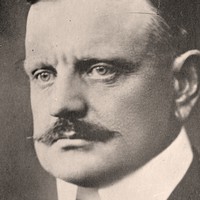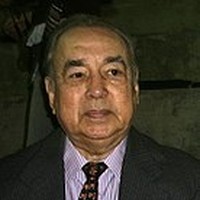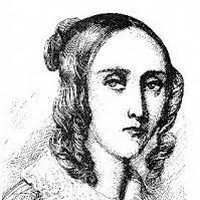Express Concert: Farrenc’s Third Symphony



(Duration: 6 min)
At the start of the twentieth century, Jean Sibelius was the leading musical voice in Finland. Just when the young country was struggling to differentiate politically and culturally from Russia, Sibelius’ orchestral works (including the Second Symphony, The Swan of Tuonela and Finlandia) emerged as national objects of pride. But Sibelius was not thriving in Helsinki; he drank heavily and spent money recklessly, until his concerned wife and friends intervened by suggesting a move to the country. The family built a remote estate, dubbed Ainola after Sibelius’ wife, Aino, and Sibelius lived there from 1904 until his death 53 years later.
Sibelius composed the Suite mignonne in 1921, within a series of light pieces that filled the eight-year gap between his Fifth and Sixth Symphonies. The French adjective “mignonne” means “delicate” or “cute,” and this three-movement suite for two flutes and strings lives up to its description, starting with the “Petit scène” that unfolds as a charming waltz. The middle movement is another dance, a Polka, with staccato flutes and plucked strings that bring extra lift to the minor-key themes. The closing Èpilogue also brings a dancing spirit to its fast outer sections, using a triplet pulse reminiscent of the gigues that concluded so many of the classic French suites of the eighteenth century.
Aaron Grad ©2024

(Duration: 6 min)
In 1903, Jean Sibelius wrote a suite of incidental music for a play titled Death, written by his brother-in-law. The next year he extracted the first selection as Valse triste (Sad Waltz), selling it to a publisher to help finance his move to Ainola. Ever since it was first performed on its own in 1904, the waltz has been one of Sibelius’ most popular concert pieces.
In its original setting in the play, Valse triste accompanies a ghostly dance by a dying mother among an imagined crowd, until the dancers vanish and only Death stands in the doorway. Muted strings establish the dark tone of the long-lined melody, while the flute and clarinet appear later in music that offers momentary optimism. The texture of the final cadence, intoned by just four violins, leaves a cold, lonely chill at the end.
Aaron Grad ©2024

(Duration: 7 min)
Just as Argentina had Ástor Piazzolla and its “tango nuevo,” and Brazil had João Gilberto and Tom Jobim developing the “bossa nova,” the big new thing to come out of mid-century Venezuela was “onda nueva,” a fusion of popular dances and sophisticated styles pioneered by Aldemaro Romero. He was a 23-year-old staff arranger at the record label RCA Victor in New York when he recorded Dinner in Caracas, a breakthrough album under his own name, featuring his string-heavy dance band. He toured widely in the decades to come, both as a nightclub entertainer and increasingly as a classical conductor, and in his later years he founded an orchestra and music conservatory in Caracas.
The Fuga con Pajarillo comes from the Suite for String Orchestra that Romero composed in 1976. The first part of the title refers to the technique of fugue that flourished in the Baroque era, with recognizable themes that make staggered entrances in an ornate tangle of counterpoint. The pajarillo refers to a folk dance related to the joropo, Venezuela’s most characteristic style that fuses African, Indigenous and European influences. It comes in a three-beat tempo reminiscent of the European waltz, but a pattern that accents the weak second beat (instead of the usual downbeat) gives it extra lift and vitality.
Aaron Grad ©2024

(Duration: 31 min)
Louise Farrenc, already an accomplished pianist, earned a coveted slot at the Paris Conservatory when she was 15. Female students were barred from training as composers, but the composition teacher Anton Reicha recognized Farrenc’s talent and gave her private lessons that continued after she got married at seventeen and left the conservatory.
Marriage often spelled the end of a composing career for even the most talented young women of her century, but Farrenc married a man who encouraged her to keep writing, and who was able to use his access as a music publisher to advance her interests. She also leaned on her own fame as a pianist, bolstered by her eventual appointment to be the only woman on the permanent faculty of the Paris Conservatory. Most of her early compositions were written for solo piano, and her later works emphasized chamber music that featured piano parts she would perform herself.
Considering the difficulties Farrenc had getting orchestral music performed (rarely) or published (never in her lifetime), it makes sense that her output was limited, comprising just two overtures from 1834 and three symphonies from the 1840s. She did manage to get her Third Symphony premiered on a prestigious Paris series in 1849 — after the esteemed old conductor died and was replaced by someone younger and more open-minded. It didn’t help that she was going against the grain of French style, taking inspiration instead from Ludwig van Beethoven and others in his German-Austrian lineage, including her own teacher Anton Reicha, who had been closely aligned with Beethoven in Vienna before coming to Paris. In that sense, her sturdy G-minor symphony is really a sibling of those by her German contemporaries who followed Beethoven’s path, especially Felix Mendelssohn and Robert Schumann.
Farrenc’s Third Symphony opens with a slow introduction, a format popularized by Franz Joseph Haydn, before proceeding into a stormy and full-throated main theme. The slow movement unfurls as a tuneful song without words, while the lively Scherzo has a light and bewitching airiness indebted to Mendelssohn. In the finale, certain melodic cutbacks and sighing phrases evoke Wolfgang Amadeus Mozart’s own symphony in the same key of G-minor, No. 40. These impulses borrowed from the German-Austrian sphere were almost subliminal in Farrenc’s language, a function of her strong training and artistic independence at a time when writing such music in France did her no favors.
Aaron Grad ©2024
Our Express Concerts are 60-75 minutes of music without intermission. Learn more at thespco.org/express.
Get driving directions and find nearby parking.
Find dining options close to the venue.
View seating charts to find out where you'll be seating.
Get driving directions and find nearby parking.
Find dining options close to the venue.
View seating charts to find out where you'll be seating.
